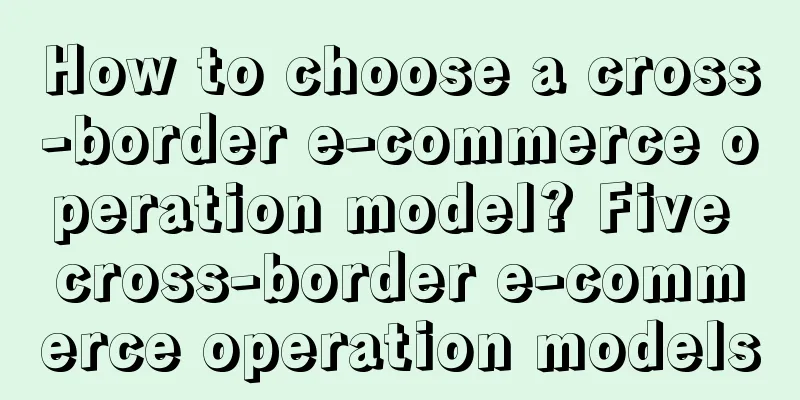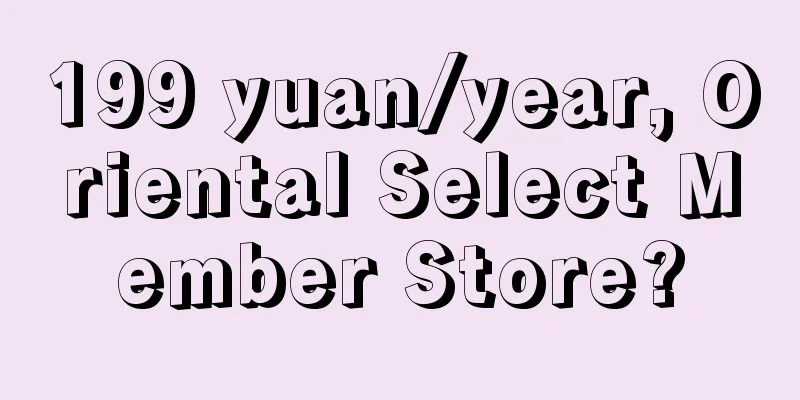How to choose a cross-border e-commerce operation model? Five cross-border e-commerce operation models

|
With the continuous development of global trade and the continuous advancement of Internet technology, the cross-border e-commerce industry is also developing rapidly. In the cross-border e-commerce industry, the operating model is very important because it is directly related to the seller's sales channels, sales strategies and profit margins. This article will discuss this issue and introduce some common cross-border e-commerce operating models. 1. How to choose a cross-border e-commerce operation model? Research the target market: Understand the cultural background, consumption habits and laws and regulations of the target market to determine whether it is suitable for cross-border e-commerce business. For example, some countries have restrictions or prohibitions on the import of certain goods, and relevant regulations need to be complied with. Product selection and positioning: Select products suitable for cross-border sales, considering the product's characteristics, brand power and competitive advantages. At the same time, determine the appropriate pricing strategy based on product attributes to meet the needs of the target market and maintain competitiveness. Resource investment and risk-taking: Assess your own resources and capabilities, and determine the corresponding funds, talents and technical support. At the same time, consider the risks you will take, such as logistics and transportation risks, payment security risks and market supervision risks. Partner selection: Find suitable suppliers, logistics partners and marketing channels. Establish good cooperative relationships and jointly promote the development of cross-border e-commerce business. 2. What are the cross-border e-commerce operation models? Self-operated model: The self-operated model means that the seller owns the product inventory and is responsible for sales and logistics. This model requires a large investment of funds and human resources, and has high requirements for brand building and after-sales service. Purchasing agent model: Purchasing agent model means that sellers purchase goods through purchasing agent channels and sell them on cross-border e-commerce platforms. This model is relatively simple and can reduce the inventory and logistics risks of goods, but it also faces challenges in supply chain stability and after-sales service. Foreign trade B2B model: Foreign trade B2B model refers to sellers trading with overseas buyers through cross-border e-commerce platforms. This model focuses on wholesale and bulk transactions, and requires attention to product quality and supply chain management. Cross-border direct mail mode: The cross-border direct mail mode means that the seller mails the goods directly from the domestic to the overseas buyers to save the middle link and reduce the cost. This mode is suitable for small-scale and light goods, but may face logistics timeliness and tariff issues. Cross-border warehousing model: The cross-border warehousing model refers to sellers setting up warehousing and logistics centers overseas to store and distribute goods. This model can improve logistics efficiency, shorten delivery time, and better meet the needs of local consumers. When choosing a cross-border e-commerce operation model, you need to consider factors such as target market, product attributes, resource investment and risk assumption. Common cross-border e-commerce operation models include self-operated model, purchasing agent model, foreign trade B2B model, cross-border direct mail model and cross-border warehousing model. Recommended reading: Which platform should I choose for my personal cross-border e-commerce business? What are the requirements for entry? How much does it cost for personal cross-border e-commerce? Do I need a deposit? Can cross-border e-commerce personal trademarks be registered? What are the regulations? |
>>: What is the purpose of cross-border e-commerce import? How to do cross-border e-commerce import?
Recommend
No one dares to be a big anchor anymore!
The article explores the current status of the liv...
How to view traffic data on Shopify? How to attract traffic?
Many people recommend Shopify for independent webs...
Do all rush orders from Shein take three hours? What are the shipping rules for Shein?
As online shopping becomes more popular, many peop...
There are still growth opportunities. Here are 6 tips on how to provide Douyin life services well.
How to provide a good service for Douyin life? Thi...
Douyin’s new e-commerce function also says “no” to low-price competition!
The "price-breaking risk" warning interc...
How to estimate and plan the budget for Xiaohongshu’s spotlight campaign?
Stephen Chow's short drama "Golden Pig an...
Eating oranges in the bath: monkeys in the rainforest fight absurdity with absurdity
They are not playing a prank, nor are they crazy, ...
With 3 million followers in 30 days, Douyin's science popularization track has ushered in "new hope"
Due to various difficulties, the science populariz...
What is the role of cross-border e-commerce product titles? Detailed introduction
The prospect of cross-border e-commerce is very go...
What impact does Amazon's suspension of sales have? In what areas?
Regarding the issue of Amazon stopping sales, in f...
Can Heytea be saved by "joint venture"?
Following cross-border collaborations with film, t...
Some common sense in BD work
Business development (BD) is an important engine f...
Can Wish deliver goods locally? How does Wish deliver goods?
Some of the merchants who have opened stores on th...
Weilong Back to School Spicy
With the start of the school year, Weilong has att...
"Dominating" Douyin and Video Account, this track finally has a "number one"
Starting from OEM, Xiahushijia quickly rose to pro...









